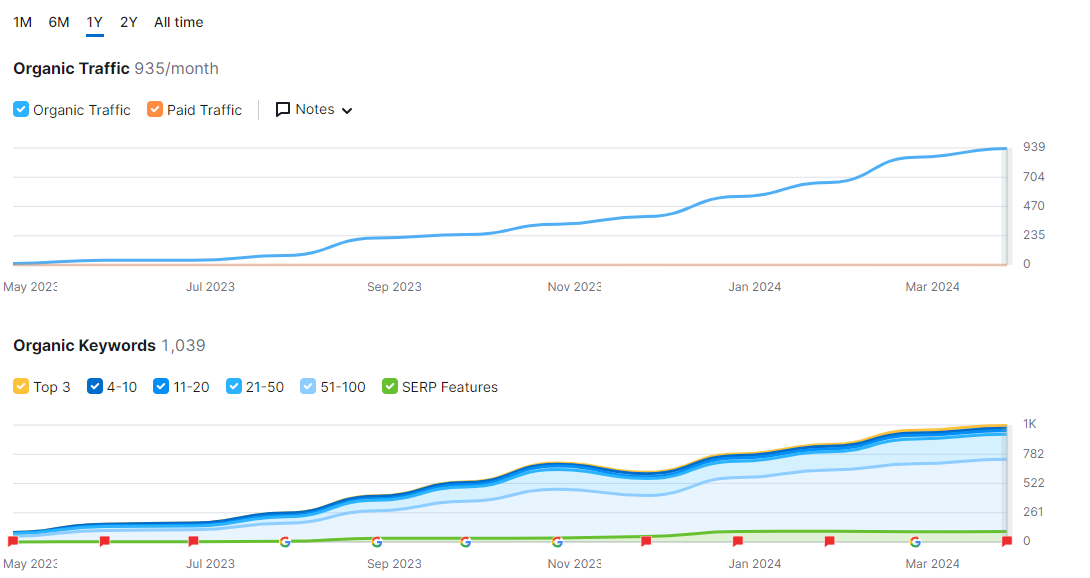Organic SEO
How To Grow An Online Company With A Shoestring Budget
I have helped many companies over the years grow their online presence. However, every now and again I find a company with little to no traffic that needs help to move their business forward. SEO for 2024 has become a game of patience and dedication and company owners who understand this are prepared to wait it out and slowly watch their company expand. Sometimes it’s not about the budget for an SEO expert, it’s about understanding the business and developing a simple and effective strategy that gets results.
Real Results Convert Into Sales & Service Requests
When a company hands over their website to you, as an SEO person, you need to consider a few simple techniques. However, you need to understand the competition, how old the company is (domain age) and if you want to target local, national or global traffic. You also need to take into consideration the design of the website and how easy or hard it is to find important pages on the website.
- Strategy with effective keyword planning
- Onsite optimisation
- Internal link building
- New content for keyword growth
- Some external link building
- Solid campaigns that work with your audience
The idea is to put into place a 12 month plan that should see results from all your efforts.

Above is a live graph from a company that had £300 a month budget for digital marketing. Challenge accepted!
How We Achieved Our Goals
In order to get effective results from building an online presence on a shoe string budget, it’s best to block out everything into 3 month cycles. Moreover, it might be wise to cut out some of the unnecessary rubbish that many companies want to get involved in.
Here our top ten no bullsh*t tactics, and yes! We will tell you this:
- Long boring meetings about nothing – keep them sharp!
- No travelling – it’s all video calls baby! Your budget doesn’t cover it
- Having too many people touching ideas and interjecting nonsense so they can have their 50p worth
- Quick decision making – let’s get moving! Your job title and experience sound lovely. Let’s crack on!
- No long reports about nothing! This is year one, a quick screen shot or SEMrush export will do
- Leave the strategy in the hands of the SEO expert
- Don’t question results and get upset about anything for at least 6 months, we don’t control or work for Google
- 1 Campaign each month spread out across socials and email
- Keep everything organic – no PR or external link building especially if the website is new
- Complete a time sheet – show the client exactly what they are investing in.
With a smile, a little whit, a hint of English sarcasm and preferably a subtle joke. Both client and SEO person know exactly where they stand and get on brilliantly. This is after all a partnership of trust and building a solid relationship. Why? You can both grow together.

Month 1-3
In the initial three months of our strategy to boost website traffic, our focus was primarily on laying a solid foundation for future growth. Firstly, we dedicated significant attention to optimising the website’s navigation and design. Ensuring intuitive navigation enhances user experience, leading to longer on-site engagement and increased likelihood of return visits. A visually appealing and user-friendly design is crucial for retaining visitors and encouraging exploration of the site’s content. Secondly, onsite SEO (Search Engine Optimisation) became a key priority. By implementing best practices such as optimising meta tags, headers, and internal linking structure, we aimed to improve the website’s visibility in search engine results pages (SERPs) and attract organic traffic. Lastly, developing a comprehensive keyword strategy was essential for targeting relevant search queries and reaching our desired audience. Conducting thorough keyword research allowed us to identify high-potential keywords and incorporate them strategically throughout the website’s content, further enhancing its search engine visibility and driving targeted traffic. Overall, prioritising navigation, design, onsite SEO, and keyword strategy in the initial phase set a strong groundwork for future traffic growth and ensured that the website was well-positioned to attract and retain visitors effectively.
Month 4-6
During months four to six of our traffic growth strategy, our primary focus shifted towards harnessing the power of local search optimisation to attract targeted traffic from our immediate vicinity. We strategically incorporated locational keywords into the website’s content, meta tags, and headings to align with the search intent of users seeking local products or services. Additionally, we bolstered our efforts by publishing blog posts tailored to address local interests and concerns, further establishing the relevance within the community. Internal link building played a crucial role in signalling to search engines the importance of key pages, thus improving their visibility in local search results. Furthermore, we enhanced the Google business page listing by optimising it with detailed product and article placements, providing potential customers with valuable information directly on the search engine results page. By prioritising local SEO tactics such as locational keywords, blog content, internal link building, and Google business page, we effectively positioned the company to capture and capitalise on local search traffic, driving growth and engagement within the target geographic area.
Month 7-9
In the third quarter of our traffic growth strategy, our attention turned towards leveraging the existing user base and expanding the business reach through targeted email marketing campaigns via platforms like Mailchimp. By crafting engaging and personalised campaigns, we aimed to nurture relationships with their current customers and encourage repeat visits to the website. Simultaneously, we ramped up the presence on social media platforms including Facebook, LinkedIn, and Pinterest, capitalising on their organic reach to attract new visitors to the website. Strategic posting schedules and audience targeting helped maximise the visibility and impact of the social media efforts. Additionally, we maintained our focus on creating valuable and informative blog posts, serving as a resource for a new audience and enhancing the website’s authority and relevance. To measure the effectiveness of all our efforts, we closely tracked conversions through form submissions for inquiries, allowing us to evaluate the success of the campaigns and make data-driven optimisations for future initiatives. By combining targeted email marketing, social media engagement, consistent blog content creation, and conversion tracking, we were able to sustain and further amplify the website traffic growth trajectory during this period.
Month 10-12
In the final quarter of our traffic growth strategy, our focus was on further expanding the scope of the business services and optimising the website to better serve their audience. We dedicated resources to creating new pages that broadened service offerings, catering to the evolving needs of customers and attracting a wider range of potential clients. Concurrently, we enhanced the user experience by optimising existing pages with frequently asked questions (FAQs) and additional rich text snippets, providing valuable information and addressing common inquiries directly on the website. We maintained our commitment to providing educational content through articles, delving deeper into industry topics and offering insights that positioned them as thought leaders in their field. Introducing new categories (using WordPress) targeted at relevant keywords facilitated internal link building, strengthening the interconnectedness of the website and improving its overall SEO performance. Furthermore, we developed compelling campaigns aligned with both new and existing service offerings, creating a cohesive narrative that resonated with the target audience and propelled their brand forward. By orchestrating a seamless sequence of content and campaigns tailored to the business model and industry, we aimed to drive sustained growth and establish this company as leaders in their targeted market segment.

A Little Philanthropy Goes A Long Way
Collaborating with companies operating on modest marketing budgets presents a unique opportunity to harness creativity and innovation in maximising impact while being mindful of financial constraints. Embracing a philanthropic approach can serve as a powerful avenue for giving back to the community while driving marketing efforts forward. By partnering with such companies, we have the chance to not only elevate their brand visibility and reach but also contribute to causes and initiatives that align with their values and resonate with their audience. Through strategic philanthropic initiatives integrated into marketing campaigns, such as donating a percentage of sales to charitable organisations or organising community-based events, we can foster meaningful connections with consumers and differentiate our partners from competitors. Emphasising philanthropy not only enhances brand perception but also creates a ripple effect of goodwill, as customers are more likely to support companies that demonstrate a commitment to social responsibility. In essence, by infusing marketing strategies with philanthropic endeavours, we not only uplift the businesses we work with but also uplift the communities they serve, leaving a lasting positive impact on society as a whole.
Hi, I’m Dave. I’ve been building websites and helping businesses grow online for over 20 years. If you think we can work together, get in touch today and say hello.

